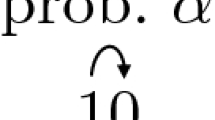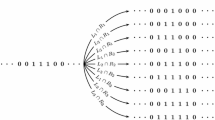Abstract
We investigate the behavior of discrete-time probabilistic cellular automata (PCA), which are Markov processes on spin configurations on ad-dimensional lattice, from a rigorous statistical mechanics point of view. In particular, we exploit, whenever possible, the correspondence between stationary measures on the space-time histories of PCAs on ℤd and translation-invariant Gibbs states for a related Hamiltonian on ℤ(d+1). This leads to a simple large-deviation formula for the space-time histories of the PCA and a proof that in a high-temperature regime the stationary states of the PCA are Gibbsian. We also obtain results about entropy, fluctuations, and correlation inequalities, and demonstrate uniqueness of the invariant state and exponential decay of correlations in a high-noise regime. We discuss phase transitions in the low-noise (or low-temperature) regime and review Toom's proof of nonergodicity of a certain class of PCAs.
Similar content being viewed by others
References
E. Domany, Exact results for two- and three-dimensional Ising and Potts models,Phys. Rev. Lett. 52:871–874 (1984).
A. M. W. Verhagen, An exactly soluble case of the triangular Ising model in a magnetic field,J. Stat. Phys. 15:219–232 (1976).
I. Peschel and V. J. Emery, Calculations of spin correlations in two-dimensional Ising systems from one-dimensional kinetic models,Z. Phys. B 43:241–249 (1981).
E. Domany and W. Kinzel, Equivalence of cellular automata to Ising models and directed percolation,Phys. Rev. Lett. 53:311–314 (1984).
P. Ferrari, J. L. Lebowitz, and C. Maes, On the positivity of correlations in nonequilibrium spin systems,J. Stat. Phys. 53:295–305 (1988).
S. Goldstein, R. Kuik, J. L. Lebowitz, and C. Maes, From PCA's to equilibrium systems and back, preprint, Rutgers University (1988).
P. Rujàn, Cellular automata and statistical mechanical models,J. Stat. Phys. 49:139–222 (1987).
A. Georges and P. Le Doussal, From equilibrium spin models to probabilistic cellular automata, preprint, Laboratoire de Physique Théorique de l'École Normal Supérieure (1987); to appear inJ. Stat. Phys. 54 (1989).
A. L. Toom, Stable and attractive trajectories in multicomponent systems, inMulticomponent Random Systems, R. L. Dobrushin and Ya. G. Sinai, eds. (Dekker, New York, 1980).
H.-O. Georgii,Gibbs Measures and Phase Transitions (de Gruyter, Berlin, 1988).
J. Stephenson, Ising model with antiferromagnetic next-nearest-neighbor coupling. Spin correlations and discrete points,Phys. Rev. B 1:4405–4409 (1970).
J. Stephenson and D. Betts, Ising model with antiferromagnetic next-nearest-neighbor coupling II. Ground states and phase diagrams,Phys. Rev. B 2:2702–2706 (1970).
T. M. Liggett,Interacting Particle Systems (Springer-Verlag, New York, 1985).
P. Gács, Reliable computation with cellular automata,J. Computer System Sci. 32:15–78 (1988).
L. Gray, The behavior of processes with statistical mechanical properties, inPercolation Theory and Ergodic Theory of Infinite Particle Systems, H. Kesten, ed. (Springer-Verlag, New York, 1987).
L. Gray, private communication.
Y. Katznelson and B. Weiss, Commuting measure-preserving transformations,Israel J. Math. 12:161–173 (1972).
I. Kanter and D. S. Fisher, Existence of ordered phases in stochastic non-equilibrium ferromagnetic Ising systems, preprint, Princeton University (1989).
C. Bennett and G. Grinstein, Role of irreversibility in stabilizing complex and nonergodic behavior in locally interacting discrete systems,Phys. Rev. Lett. 55:657–660 (1985).
B. M. Boghosian and C. D. Levermore, A cellular automaton for Burger's equation,Complex Systems 1:17–29 (1987); C. Burges and S. Zaleski, Buoyant mixtures of cellular automaton gases,Complex Systems 1:31–49 (1987).
V. A. Malyshev, The central limit theorem for Gibbsian random fields,Soviet Math. Dokl. 16:1141–1145 (1975).
C. M. Newman, A general central limit theorem for FKG systems,Commun. Math. Phys. 91:75–80 (1983).
O. E. Lanford, Entropy and equilibrium states in classical statistical mechanics, inStatistical Mechanics and Mathematical Problems, A. Lenard, ed. (Lecture Notes in Physics, Vol. 20, 1971), pp. 1–113.
R. S. Ellis,Entropy, Large Deviations and Statistical Mechanics (Springer-Verlag, New York, 1985).
J. L. Lebowitz and R. H. Schonmann, On the asymptotics of occurrence times of rare events for stochastic spin systems,J. Stat. Phys. 48:727–751 (1987).
J. L. Lebowitz and R. H. Schonmann, Pseudo-free energies and large deviations for non Gibbsian FKG measures,Prob. Theory Related Fields 77:49–64 (1988).
R. B. Griffiths, Rigorous results and theorems, inPhase Transitions and Critical Phenomena, Vol. I, C. Domb and M. Green, eds. (Academic Press, New York, 1972).
R. Fernàndez and J. Slawny, Inequalities and many phase transitions in ferromagnetic systems,Commun. Math. Phys. 121:91–120 (1989).
C. M. Fortuin, J. Ginibre, and P. W. Kasteleyn, Correlation inequalities on some partially ordered sets,Commun. Math. Phys. 22:89–103 (1971).
J. L. Lebowitz, Bounds on the correlations and analyticity properties of ferromagnetic Ising spin systems,Commun. Math. Phys. 28:313–321 (1972).
J. L. Lebowitz and A. Martin-Löf, On the uniqueness of the equilibrium states for Ising spin systems,Commun. Math. Phys. 25:276–282 (1972).
R. L. Dobrushin and S. B. Shlosman, Completely analytic interactions: Constructive description,J. Stat. Phys. 46:983–1014 (1987).
G. Gallavotti and S. Miracle-Sole, Correlation functions of a lattice system,Commun. Math. Phys. 7:274–288 (1968).
R. L. Dobrushin and S. B. Shlosman, Constructive criterion for the uniqueness of a Gibbs field, inStatistical Mechanics and Dynamical Systems, J. Fritz, A. Jaffe, and D. Szász, eds. (Birkhauser, Boston, 1985), pp. 347–370.
R. L. Dobrushin, The description of a random field by means of conditional probabilities and its regularity,Theor. Prob. Appl. 13:197–224 (1968).
R. Holley and D. Stroock, Dual processes and their application to infinite interacting systems,Adv. Math. 32:149–174 (1979).
L. N. Vasershtein, Markov processes over denumerable products of spaces, describing large systems of automata,Problems Inform. Transmission 5:47–52 (1969).
R. L. Dobrushin, Markov processes with a large number of locally interacting components: Existence of a limit process and its ergodicity,Problems Inform. Transmission 7:149–164 (1971).
J. Steif,d-Convergence to equilibrium and space-time Bernoullicity for spin systems in theM<ε case, preprint, Rutgers University (1989).
H. Kiinsch, Non reversible stationary measures for infinite interacting particle systems,Z. Wahrsch. Verw. Geb. 66:407–424 (1984).
C. J. Preston,Gibbs States on Countable Sets (Cambridge University Press, Cambridge, 1974).
C. Bennett, private communication.
S. A. Pirogov and Ya. G. Sinai, Phase diagrams for classical lattice systems,Theor. Math. Phys. 25:1185–1192;26:39–49 (1976).
J. Slawny, Low temperature properties of classical lattice systems: Phase transitions and phase diagrams, inPhase Transitions and Critical Phenomena, Vol. 11, C. Domb and J. L. Lebowitz, eds. (Academic Press, 1986).
J. Bricmont and J. Slawny, Phase transitions in systems with a finite number of dominant ground states,J. Stat. Phys. 54:89–161 (1989).
J. Park, K. Stieglitz, and W. Thurston, Soliton-like behavior in automata,Physica 19D (1986).
A. S. Fokas, E. Papadopoulou, Y. Saridakis, and M. J. Ablowitz, Interaction of simple particles in soliton cellular automata, preprint, Institute for Nonlinear Studies; to appear inStud. Appl. Math.
J. L. Lebowitz and C. Maes, The effect of an external field on an interface, entropic repulsion,J. Stat. Phys. 46:39–49 (1987).
T. C. Dorlas and A. C. D. Van Enter, Non-Gibbsian limit for large-block majority-spin transformation, to appear inJ. Stat. Phys. 55 (1989).
L. Gray, private communication.
Author information
Authors and Affiliations
Rights and permissions
About this article
Cite this article
Lebowitz, J.L., Maes, C. & Speer, E.R. Statistical mechanics of probabilistic cellular automata. J Stat Phys 59, 117–170 (1990). https://doi.org/10.1007/BF01015566
Received:
Revised:
Issue Date:
DOI: https://doi.org/10.1007/BF01015566




